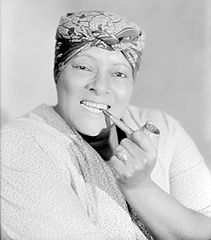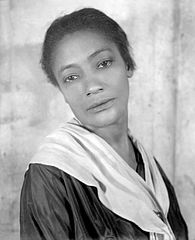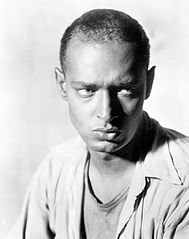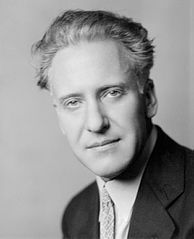Porgy (play): Difference between revisions
KolbertBot (talk | contribs) m Bot: HTTP→HTTPS (v481) |
m I added a link to the "short novel" Wikipedia page so readers could have more context. Tags: Visual edit Mobile edit Mobile web edit |
||
| (14 intermediate revisions by 10 users not shown) | |||
| Line 1: | Line 1: | ||
{{Short description|Play by Dorothy Heyward and DuBose Heyward}} |
|||
{{Use American English|date=December 2022}} |
|||
{{Use mdy dates|date=December 2022}} |
|||
{{Infobox play |
{{Infobox play |
||
| name = Porgy: A Play in Four Acts |
| name = Porgy: A Play in Four Acts |
||
| Line 22: | Line 25: | ||
}} |
}} |
||
'''''Porgy: A Play in Four Acts''''' is a play by [[Dorothy Heyward]] and [[DuBose Heyward]], adapted from the [[ |
'''''Porgy: A Play in Four Acts''''' is a play by [[Dorothy Heyward]] and [[DuBose Heyward]], adapted from the [[short novel]] [[Porgy (novel)|by DuBose Heyward.]] It was first produced by the [[Theatre Guild]] and presented October 10, 1927 – August 1928 at the [[August Wilson Theatre|Guild Theatre]] in New York City. Featuring a cast of African Americans at the insistence of its authors—a decision unusual for its time—the original production starred [[Frank H. Wilson|Frank Wilson]], [[Evelyn Ellis]], [[Jack Carter (actor)|Jack Carter]], and [[Rose McClendon]]. ''Porgy'' marked the Broadway directing debut of [[Rouben Mamoulian]]. The play ran a total of 55 weeks in New York, and the original cast toured the United States twice and performed for 11 consecutive weeks in London. |
||
The play tells the story of Porgy, a disabled black beggar who lives in the slums of [[Charleston, South Carolina]]. It relates his efforts to rescue Bess, the woman he loves, from Crown, her violent and possessive lover, and a drug dealer called Sporting Life. |
The play tells the story of Porgy, a disabled black beggar who lives in the slums of [[Charleston, South Carolina]]. It relates his efforts to rescue Bess, the woman he loves, from Crown, her violent and possessive lover, and a drug dealer called Sporting Life. |
||
| Line 30: | Line 33: | ||
==History== |
==History== |
||
[[File:Porgy-DuBose-Dorothy-Heyward.jpg|thumb|left|upright|[[DuBose Heyward|DuBose]] and [[Dorothy Heyward]], authors of the play ''Porgy'']] |
[[File:Porgy-DuBose-Dorothy-Heyward.jpg|thumb|left|upright|[[DuBose Heyward|DuBose]] and [[Dorothy Heyward]], authors of the play ''Porgy'']] |
||
A |
A descendant of [[Thomas Heyward, Jr.]], [[DuBose Heyward]] was from an old, white family in Charleston, South Carolina. In 1925, he published his first and best-regarded novel, ''Porgy'',<ref name="Gale 1">(Edwin) DuBose Heyward 1885–1940. ''Contemporary Authors Online'', [[Gale (publisher)|Gale]], November 5, 2003.</ref> which was inspired by a news story and drawn from his sympathetic observations of African American culture.<ref name="Gale 2">Dorothy (Hartzell Kuhns) Heyward 1890–1961. ''Contemporary Authors Online'', [[Gale (publisher)|Gale]], March 3, 2000.</ref> The book was a best seller.<ref name="NYT Schiff">{{cite news |last=Schiff |first=David |date=March 5, 2000 |title=The Man Who Breathed Life Into 'Porgy and Bess' |url=https://www.nytimes.com/2000/03/05/arts/the-man-who-breathed-life-into-porgy-and-bess.html?pagewanted=1&pagewanted=all |newspaper=[[The New York Times]] |access-date=March 3, 2015 }}</ref> ''Porgy'' was one of a number of works portraying black life written by white authors, but it was infused with human understanding at a time that such an approach was new.<ref name="NYT Gaither">{{cite news |last=Gaither |first=Frances |date=April 25, 1954 |title=At the Heart of Catfish Row |newspaper=The New York Times |page=136 }}</ref> |
||
Heyward's wife, playwright [[Dorothy Heyward]], roughed out a stage adaptation of the novel that persuaded her husband of the story's dramatic possibilities. They wrote the play together, strengthening the character of Bess, incorporating folk songs, and creating a more upbeat ending that shows Porgy following Bess to New York.<ref name="NYT Schiff"/><ref name="Gale 2"/> |
Heyward's wife, playwright [[Dorothy Heyward]], roughed out a stage adaptation of the novel that persuaded her husband of the story's dramatic possibilities. They wrote the play together, strengthening the character of Bess, incorporating folk songs, and creating a more upbeat ending that shows Porgy following Bess to New York.<ref name="NYT Schiff"/><ref name="Gale 2"/> |
||
Just as the novel had been one of the first to regard African American culture seriously, ''Porgy'' was the first authentic presentation of black culture on the Broadway stage.<ref name="Gale 1"/> The Heywards insisted that an African American cast perform the play, providing much-needed employment for black actors and offering white audiences a mature view of African American life.<ref name="Gale 2"/> DuBose Heyward credited the actors—many of whom had |
Just as the novel had been one of the first to regard African American culture seriously, ''Porgy'' was the first authentic presentation of black culture on the Broadway stage.<ref name="Gale 1"/> The Heywards insisted that an African American cast perform the play, providing much-needed employment for black actors and offering white audiences a mature view of African American life.<ref name="Gale 2"/> DuBose Heyward credited the actors—many of whom had theater experience going back generations—as collaborators whose contributions transformed the drama on the stage.<ref name="NYT Schiff"/> |
||
==Production== |
==Production== |
||
Sponsored by the [[Theatre Guild]], ''Porgy'' was given its premiere on [[Broadway theatre|Broadway]], running October 10, 1927, to August 1928, at the [[August Wilson Theatre|Guild Theatre]]<ref name="IBDB Porgy 1">{{cite web|url=http://ibdb.com/production.php?id=10467 |title=Porgy |publisher=Internet Broadway Database |accessdate=2015 |
Sponsored by the [[Theatre Guild]], ''Porgy'' was given its premiere on [[Broadway theatre|Broadway]], running October 10, 1927, to August 1928, at the [[August Wilson Theatre|Guild Theatre]]<ref name="IBDB Porgy 1">{{cite web|url=http://ibdb.com/production.php?id=10467 |title=Porgy |publisher=Internet Broadway Database |accessdate=March 3, 2015}}</ref> and the [[New Victory Theater|Republic Theatre]].<ref name="Republic Porgy">[[New Victory Theatre|Republic Theatre]], The New York Magazine Program. ''Porgy'', week beginning July 2, 1928.</ref> |
||
''Porgy'' then went on |
''Porgy'' then went on tour—for nine weeks in Chicago,<ref name="Scrapbooks"/> 11 weeks in London,<ref name="Denton"/> and in cities including Boston, Philadelphia, Cincinnati, Washington, Cleveland, Pittsburgh, Baltimore, Detroit, San Francisco, Los Angeles, and others in the northwestern United States and Canada.<ref name="Scrapbooks">{{cite web|url=http://archives.nypl.org/scm/20736 |title=Rose McClendon Scrapbooks |publisher=Manuscripts, Archives and Rare Books Division, The [[New York Public Library]] |accessdate=March 3, 2015}}</ref> The show returned to New York, running September 13 to October 1929 at the [[Al Hirschfeld Theatre|Martin Beck Theatre]].<ref name="IBDB Porgy 2">{{cite web|url=http://ibdb.com/production.php?id=9424 |title=Porgy |publisher=Internet Broadway Database |accessdate=March 3, 2015}}</ref> |
||
After a total of 55 weeks in New York, all of the original principal cast members of ''Porgy'' toured the nation once again, performing from October 14, 1929,<ref name="Denton">{{cite news |author=<!--Staff writer(s); no by-line.--> |date=October 12, 1929 |title='Porgy' Returns to Fords, Baltimore, After Scoring Triumph in London |
After a total of 55 weeks in New York, all of the original principal cast members of ''Porgy'' toured the nation once again, performing from October 14, 1929,<ref name="Denton">{{cite news |author=<!--Staff writer(s); no by-line.--> |date=October 12, 1929 |title='Porgy' Returns to Fords, Baltimore, After Scoring Triumph in London |newspaper=Denton Journal |location=[[Denton, Maryland]] |page=4 }}</ref> into January 1930.<ref>{{cite news |author=<!--Staff writer(s); no by-line.--> |date=January 5, 1930 |title=Players in 'Porgy', Which Comes to Garrick Monday |newspaper=[[The Capital Times]] |page=6 }}</ref> |
||
''Porgy'' marked the Broadway directing debut of [[Rouben Mamoulian]].<ref>{{cite web|url=http://ibdb.com/person.php?id=8497 |title=Rouben Mamoulian |publisher=Internet Broadway Database |accessdate=2015 |
''Porgy'' marked the Broadway directing debut of [[Rouben Mamoulian]].<ref>{{cite web|url=http://ibdb.com/person.php?id=8497 |title=Rouben Mamoulian |publisher=Internet Broadway Database |accessdate=March 3, 2015}}</ref> Settings were designed by [[Cleon Throckmorton]].<ref name="Republic Porgy"/> Portraying an aristocratic Charleston attorney, [[Erskine Sanford]] was one of only three white actors in the 65-member cast of ''Porgy''.<ref>{{cite news |author=<!--Staff writer(s); no by-line.--> |date=December 29, 1929 |title='Porgy' Lead Has Played Very Often for Theater Guild |newspaper=The Capital Times |page=6 }}</ref> The boys band from the [[Jenkins Orphanage]] of Charleston was also featured.<ref name="Denton"/> |
||
<gallery mode=packed heights=160px> |
<gallery mode=packed heights=160px> |
||
File:Porgy-Catfish-Row.jpg|Setting for Catfish Row by Cleon Throckmorton |
File:Porgy-Catfish-Row.jpg|Setting for Catfish Row by [[Cleon Throckmorton]] |
||
File:Porgy-Verwayne-Wilson-Ellis.jpg|Percy Verwayne (Sporting Life), [[Frank H. Wilson|Frank Wilson]] (Porgy) and [[Evelyn Ellis]] (Bess) |
File:Porgy-Verwayne-Wilson-Ellis.jpg|Percy Verwayne (Sporting Life), [[Frank H. Wilson|Frank Wilson]] (Porgy) and [[Evelyn Ellis]] (Bess) |
||
File:Porgy-Harvey-Verwayne.jpg|[[Georgette Harvey]] (Maria) and Percy Verwayne (Sporting Life) |
File:Porgy-Harvey-Verwayne.jpg|[[Georgette Harvey]] (Maria) and Percy Verwayne (Sporting Life) |
||
File:Porgy-Georgette-Harvey.jpg|Georgette Harvey (Maria) |
File:Porgy-Georgette-Harvey.jpg|Georgette Harvey (Maria) |
||
File:Porgy-Percy-Verwayne.jpg|Percy Verwayne (Sporting Life) |
File:Porgy-Percy-Verwayne.jpg|[[Percy Verwayne]] (Sporting Life) |
||
File:Porgy-Rose-McClendon.jpg|[[Rose McClendon]] (Serena) |
File:Porgy-Rose-McClendon.jpg|[[Rose McClendon]] (Serena) |
||
File:Porgy-Jack-Carter.jpg|[[Jack Carter (actor)|Jack Carter]] (Crown) |
File:Porgy-Jack-Carter.jpg|[[Jack Carter (actor)|Jack Carter]] (Crown) |
||
| Line 66: | Line 69: | ||
*Mingo … Richard Huey<ref name="IBDB Porgy 1"/><ref name="Republic Porgy"/> |
*Mingo … Richard Huey<ref name="IBDB Porgy 1"/><ref name="Republic Porgy"/> |
||
*Annie … Ella Madison<ref name="IBDB Porgy 1"/><ref name="Republic Porgy"/> |
*Annie … Ella Madison<ref name="IBDB Porgy 1"/><ref name="Republic Porgy"/> |
||
*Sporting Life … Percy Verwayne<ref name="IBDB Porgy 1"/><ref name="Republic Porgy"/> |
*Sporting Life … [[Percy Verwayne]]<ref name="IBDB Porgy 1"/><ref name="Republic Porgy"/> |
||
*Serena, Robbins' wife … [[Rose McClendon]]<ref name="Republic Porgy"/><ref name="IBDB Porgy 1"/> |
*Serena, Robbins' wife … [[Rose McClendon]]<ref name="Republic Porgy"/><ref name="IBDB Porgy 1"/> |
||
*Robbins, a young stevedore … Lloyd Gray<ref name="IBDB Porgy 1"/><ref name="Republic Porgy"/> |
*Robbins, a young stevedore … Lloyd Gray<ref name="IBDB Porgy 1"/><ref name="Republic Porgy"/> |
||
| Line 79: | Line 82: | ||
*Undertaker … [[Leigh Whipper]]<ref name="Republic Porgy"/> |
*Undertaker … [[Leigh Whipper]]<ref name="Republic Porgy"/> |
||
*Scipio … Melville Greene<ref name="Republic Porgy"/> |
*Scipio … Melville Greene<ref name="Republic Porgy"/> |
||
*Simon Frazier, a lawyer … A. B. Comathiere<ref name="Republic Porgy"/> |
*Simon Frazier, a lawyer … [[A. B. Comathiere]]<ref name="Republic Porgy"/> |
||
*Alan Archdale … [[Erskine Sanford]]<ref name="Republic Porgy"/> |
*Alan Archdale … [[Erskine Sanford]]<ref name="Republic Porgy"/> |
||
*The Crab Man … Leigh Whipper<ref name="IBDB Porgy 1"/><ref name="Republic Porgy"/> |
*The Crab Man … Leigh Whipper<ref name="IBDB Porgy 1"/><ref name="Republic Porgy"/> |
||
*The Coroner … Garrett Minturn<ref name="IBDB Porgy 1"/><ref name="Republic Porgy"/> |
*The Coroner … Garrett Minturn<ref name="IBDB Porgy 1"/><ref name="Republic Porgy"/> |
||
*Residents of Catfish Row, Fishermen, Children, Stevedores, etc. … Clarissa Blue, Marguerite Booth, Lillian Cowan, Zora Donahoo, Catherine Francis, Ella Gordon, Rosa Johnson, Marie Remsen, Musa Williams, Frank Allen, Edward Perry, Smith Reed, Charles Taylor, Philip Thomas, Carl Mahon, Edward Chauers, Teddie Brown, Richard Bruce, Mable Ridley, John Dowling<ref name="Republic Porgy"/> |
*Residents of Catfish Row, Fishermen, Children, Stevedores, etc. … Clarissa Blue, Marguerite Booth, Lillian Cowan, Zora Donahoo, Catherine Francis, Ella Gordon, Rosa Johnson, Marie Remsen, Musa Williams, Frank Allen, Edward Perry, Smith Reed, Charles Taylor, Philip Thomas, [[Carl Mahon]], Edward Chauers, Teddie Brown, Richard Bruce, Mable Ridley, John Dowling<ref name="Republic Porgy"/> |
||
}} |
}} |
||
==Publication== |
==Publication== |
||
The Theatre Guild acting version of the play ''Porgy'' was published in 1927 by Doubleday, Doran and Company.<ref>{{cite book |last1=Heyward |first1=Dorothy |last2=Heyward |first2=DuBose |date=1927 |title=Porgy: A Play in Four Acts |url= |location=Garden City, N.Y. |publisher=Doubleday, Doran and Company |oclc=228699754 |
The Theatre Guild acting version of the play ''Porgy'' was published in 1927 by Doubleday, Doran and Company.<ref>{{cite book |last1=Heyward |first1=Dorothy |last2=Heyward |first2=DuBose |date=1927 |title=Porgy: A Play in Four Acts |url=https://babel.hathitrust.org/cgi/pt?id=uc1.b4097847&view=1up&seq=9 |location=Garden City, N.Y. |publisher=Doubleday, Doran and Company |oclc=228699754 }}</ref> |
||
==References== |
==References== |
||
| Line 94: | Line 97: | ||
==External links== |
==External links== |
||
{{Commons category|Porgy (play)}} |
{{Commons category|Porgy (play)}} |
||
* [https://babel.hathitrust.org/cgi/pt?id=uc1.b4097847&view=1up&seq=9 Full text of ''Porgy'' at HathiTrust Digital Library] |
|||
* {{IBDB title | 10467 | Porgy}} |
* {{IBDB title | 10467 | Porgy}} |
||
* [https://digitalcollections.nypl.org/collections/vandamm-theatrical-photographs-1900-1957#/?tab=navigation&roots=0e546ea0-c5ab-012f-2db0-58d385a7bc34/137:bc4ea300-c5ad-012f-ba39-58d385a7bc34 Production photographs] from the Vandamm Theatrical Photographs collection at the [[New York Public Library]] |
* [https://digitalcollections.nypl.org/collections/vandamm-theatrical-photographs-1900-1957#/?tab=navigation&roots=0e546ea0-c5ab-012f-2db0-58d385a7bc34/137:bc4ea300-c5ad-012f-ba39-58d385a7bc34 Production photographs] from the Vandamm Theatrical Photographs collection at the [[New York Public Library]] |
||
| Line 104: | Line 108: | ||
[[Category:Plays by Dorothy Heyward]] |
[[Category:Plays by Dorothy Heyward]] |
||
[[Category:Porgy and Bess]] |
[[Category:Porgy and Bess]] |
||
[[Category:Plays adapted into operas]] |
|||
Latest revision as of 04:39, 9 January 2024
| Porgy: A Play in Four Acts | |
|---|---|
 First edition | |
| Written by | |
| Date premiered | October 10, 1927 |
| Place premiered | Guild Theatre, New York City, New York |
Porgy: A Play in Four Acts is a play by Dorothy Heyward and DuBose Heyward, adapted from the short novel by DuBose Heyward. It was first produced by the Theatre Guild and presented October 10, 1927 – August 1928 at the Guild Theatre in New York City. Featuring a cast of African Americans at the insistence of its authors—a decision unusual for its time—the original production starred Frank Wilson, Evelyn Ellis, Jack Carter, and Rose McClendon. Porgy marked the Broadway directing debut of Rouben Mamoulian. The play ran a total of 55 weeks in New York, and the original cast toured the United States twice and performed for 11 consecutive weeks in London.
The play tells the story of Porgy, a disabled black beggar who lives in the slums of Charleston, South Carolina. It relates his efforts to rescue Bess, the woman he loves, from Crown, her violent and possessive lover, and a drug dealer called Sporting Life.
The play is the basis of the libretto of the opera Porgy and Bess (1935).
History
[edit]
A descendant of Thomas Heyward, Jr., DuBose Heyward was from an old, white family in Charleston, South Carolina. In 1925, he published his first and best-regarded novel, Porgy,[1] which was inspired by a news story and drawn from his sympathetic observations of African American culture.[2] The book was a best seller.[3] Porgy was one of a number of works portraying black life written by white authors, but it was infused with human understanding at a time that such an approach was new.[4]
Heyward's wife, playwright Dorothy Heyward, roughed out a stage adaptation of the novel that persuaded her husband of the story's dramatic possibilities. They wrote the play together, strengthening the character of Bess, incorporating folk songs, and creating a more upbeat ending that shows Porgy following Bess to New York.[3][2]
Just as the novel had been one of the first to regard African American culture seriously, Porgy was the first authentic presentation of black culture on the Broadway stage.[1] The Heywards insisted that an African American cast perform the play, providing much-needed employment for black actors and offering white audiences a mature view of African American life.[2] DuBose Heyward credited the actors—many of whom had theater experience going back generations—as collaborators whose contributions transformed the drama on the stage.[3]
Production
[edit]Sponsored by the Theatre Guild, Porgy was given its premiere on Broadway, running October 10, 1927, to August 1928, at the Guild Theatre[5] and the Republic Theatre.[6]
Porgy then went on tour—for nine weeks in Chicago,[7] 11 weeks in London,[8] and in cities including Boston, Philadelphia, Cincinnati, Washington, Cleveland, Pittsburgh, Baltimore, Detroit, San Francisco, Los Angeles, and others in the northwestern United States and Canada.[7] The show returned to New York, running September 13 to October 1929 at the Martin Beck Theatre.[9]
After a total of 55 weeks in New York, all of the original principal cast members of Porgy toured the nation once again, performing from October 14, 1929,[8] into January 1930.[10]
Porgy marked the Broadway directing debut of Rouben Mamoulian.[11] Settings were designed by Cleon Throckmorton.[6] Portraying an aristocratic Charleston attorney, Erskine Sanford was one of only three white actors in the 65-member cast of Porgy.[12] The boys band from the Jenkins Orphanage of Charleston was also featured.[8]
-
Setting for Catfish Row by Cleon Throckmorton
-
Percy Verwayne (Sporting Life), Frank Wilson (Porgy) and Evelyn Ellis (Bess)
-
Georgette Harvey (Maria) and Percy Verwayne (Sporting Life)
-
Georgette Harvey (Maria)
-
Percy Verwayne (Sporting Life)
-
Rose McClendon (Serena)
-
Jack Carter (Crown)
-
Evelyn Ellis (Bess)
-
Erskine Sanford (Alan Archdale)
-
Leigh Whipper (The Crab Man)
Cast
[edit]The original cast members are listed in order of appearance.[6]
- Maria, keeper of the cookshop … Georgette Harvey[5][6]
- Jake, captain of the fishing fleet … Wesley Hill[5][6]
- Lily … Dorothy Paul[5][6]
- Mingo … Richard Huey[5][6]
- Annie … Ella Madison[5][6]
- Sporting Life … Percy Verwayne[5][6]
- Serena, Robbins' wife … Rose McClendon[6][5]
- Robbins, a young stevedore … Lloyd Gray[5][6]
- Jim, a stevedore … Peter Clark[5][6]
- Clara, Jake's wife … Marie Young[5][6]
- Peter, the honeyman … Hayes Pryor[5][6]
- Porgy, a crippled beggar … Frank Wilson[5][6]
- Crown, a stevedore … Jack Carter[5][6]
- Crown's Bess … Evelyn Ellis[5][6]
- A Detective … Stanley DeWolfe[5][6]
- Two Policemen … Maurice McRae, Hugh Rennie[5]
- Undertaker … Leigh Whipper[6]
- Scipio … Melville Greene[6]
- Simon Frazier, a lawyer … A. B. Comathiere[6]
- Alan Archdale … Erskine Sanford[6]
- The Crab Man … Leigh Whipper[5][6]
- The Coroner … Garrett Minturn[5][6]
- Residents of Catfish Row, Fishermen, Children, Stevedores, etc. … Clarissa Blue, Marguerite Booth, Lillian Cowan, Zora Donahoo, Catherine Francis, Ella Gordon, Rosa Johnson, Marie Remsen, Musa Williams, Frank Allen, Edward Perry, Smith Reed, Charles Taylor, Philip Thomas, Carl Mahon, Edward Chauers, Teddie Brown, Richard Bruce, Mable Ridley, John Dowling[6]
Publication
[edit]The Theatre Guild acting version of the play Porgy was published in 1927 by Doubleday, Doran and Company.[13]
References
[edit]- ^ a b (Edwin) DuBose Heyward 1885–1940. Contemporary Authors Online, Gale, November 5, 2003.
- ^ a b c Dorothy (Hartzell Kuhns) Heyward 1890–1961. Contemporary Authors Online, Gale, March 3, 2000.
- ^ a b c Schiff, David (March 5, 2000). "The Man Who Breathed Life Into 'Porgy and Bess'". The New York Times. Retrieved March 3, 2015.
- ^ Gaither, Frances (April 25, 1954). "At the Heart of Catfish Row". The New York Times. p. 136.
- ^ a b c d e f g h i j k l m n o p q r s "Porgy". Internet Broadway Database. Retrieved March 3, 2015.
- ^ a b c d e f g h i j k l m n o p q r s t u v w x y Republic Theatre, The New York Magazine Program. Porgy, week beginning July 2, 1928.
- ^ a b "Rose McClendon Scrapbooks". Manuscripts, Archives and Rare Books Division, The New York Public Library. Retrieved March 3, 2015.
- ^ a b c "'Porgy' Returns to Fords, Baltimore, After Scoring Triumph in London". Denton Journal. Denton, Maryland. October 12, 1929. p. 4.
- ^ "Porgy". Internet Broadway Database. Retrieved March 3, 2015.
- ^ "Players in 'Porgy', Which Comes to Garrick Monday". The Capital Times. January 5, 1930. p. 6.
- ^ "Rouben Mamoulian". Internet Broadway Database. Retrieved March 3, 2015.
- ^ "'Porgy' Lead Has Played Very Often for Theater Guild". The Capital Times. December 29, 1929. p. 6.
- ^ Heyward, Dorothy; Heyward, DuBose (1927). Porgy: A Play in Four Acts. Garden City, N.Y.: Doubleday, Doran and Company. OCLC 228699754.
External links
[edit]- Full text of Porgy at HathiTrust Digital Library
- Porgy at the Internet Broadway Database
- Production photographs from the Vandamm Theatrical Photographs collection at the New York Public Library










